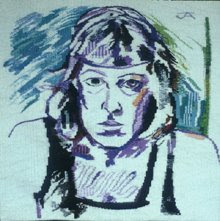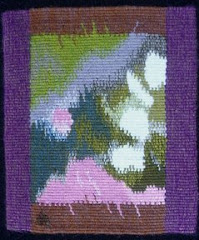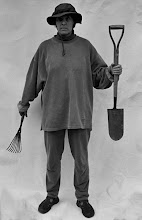How did I miss seeing this for so many years? I was in Paris in 2000, but for some reason this was not on my MUST SEE list…I was in Paris in 1972, while I was an art student, and spent every day in the Louvre, but that was before I knew anything about tapestry. This time I had only one day to visit museums, and this was my top choice.

The Cluny Abbot Hotel was built, as a residence for the abbots, at the end of the 15th century, next door to the “thermes,” Gallo-Roman Baths dating to the 1st-3rd centuries. The building is beautiful, in that magical medieval style.
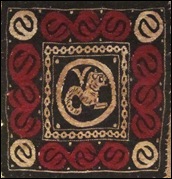 Before we found the Lady and the Unicorn Tapestries we were pleasantly surprised by an exhibit of Coptic tapestry fragments from 5th and 6th century Egypt.
Before we found the Lady and the Unicorn Tapestries we were pleasantly surprised by an exhibit of Coptic tapestry fragments from 5th and 6th century Egypt.

I know that many tiny Coptic tapestries were either applied to, or woven into garments. They are well known for their use of eccentric wefts.
The Copts were (and are) a population of Christians living in Egypt, and their tapestries are legendary in textile history. What a thrill to see these up close.
Finally, the Lady and the Unicorn tapestries. I was practically speechless (which anyone who knows me would realize is quite unusual!)
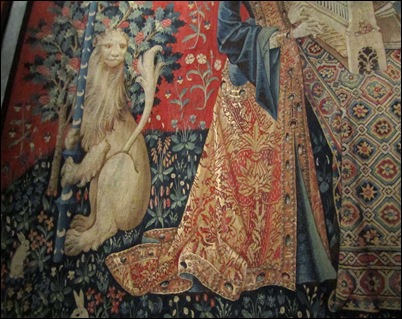 As a tapestry weaver I am so impressed with the technical virtuosity necessary to achieve the designs (like the patterns in the Lady’s dresses, for example). As an artist it is clear that these tapestries were designed by a master of composition.
As a tapestry weaver I am so impressed with the technical virtuosity necessary to achieve the designs (like the patterns in the Lady’s dresses, for example). As an artist it is clear that these tapestries were designed by a master of composition.
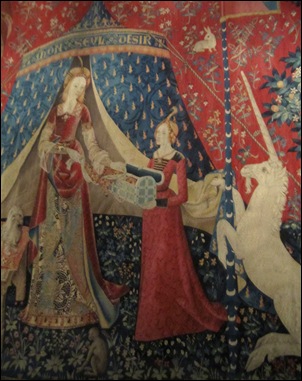 They are so well preserved, the colors are bright and most of the silk yarns are still there, and still lustrous (silk can often become brittle and just fall apart over time). That said, the bottom edges had rotted and been replaced at one time.
They are so well preserved, the colors are bright and most of the silk yarns are still there, and still lustrous (silk can often become brittle and just fall apart over time). That said, the bottom edges had rotted and been replaced at one time.
(please excuse the poor quality of the photos…the light in the gallery is very low, to protect the tapestries from further fading, and flash photography is forbidden)
As is often the case with old tapestries, there is a lot of uncertainty and controversy about their exact meaning. 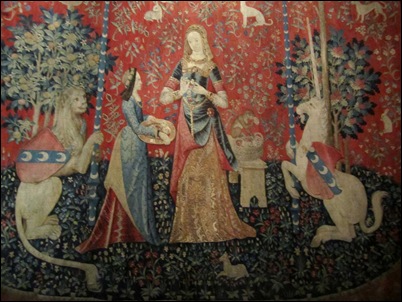
Experts believe that these tapestries are about the 5 senses: Touch, Taste, Smell, Hearing and Sight, plus a sixth sense: The Heart, or perhaps, Understanding. “A Mon Seul Désir” (To My Only Desire) is inscribed on a banner in this sixth tapestry. The symbolism is far too complex for me to write about. Apart from the lady herself, the lion, the unicorn, the trees, and her lady in waiting, there is a mille fleurs background, and many animals. Nothing is insignificant.

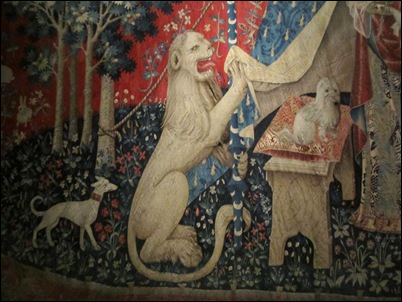 You can get some information, and see complete photos on Wikipedia. I love that it says it “is often considered one of the greatest works of art of the Middle Ages in Europe.” YEAH!
You can get some information, and see complete photos on Wikipedia. I love that it says it “is often considered one of the greatest works of art of the Middle Ages in Europe.” YEAH!
There is also information on Tracy Chevalier’s website (she wrote the novel “The Lady and the Unicorn”).
I bought a book in the gift shop: The Lady and the Unicorn, by Elisabeth Delahaye, Director, Musee de Cluny, 2007. ISBN: 978 2711 850358. The photos are wonderful, and the author does a good job of explaining things in just 96 pages.
It is not available on Amazon.com. There are 2 copies at www.abebooks.com, the English one is about $30, but the French one is $668.75 (???). You might be able to order the book from the museum gift shop for 18 Euros, but I don’t know if they will ship to the USA, or how much that would cost. Make sure you order the English version, unless, of course, you prefer French.
